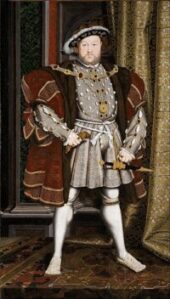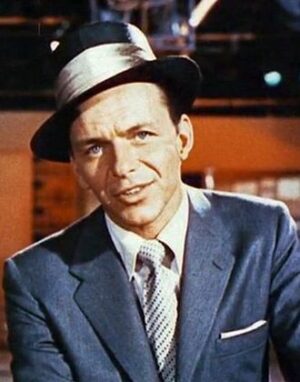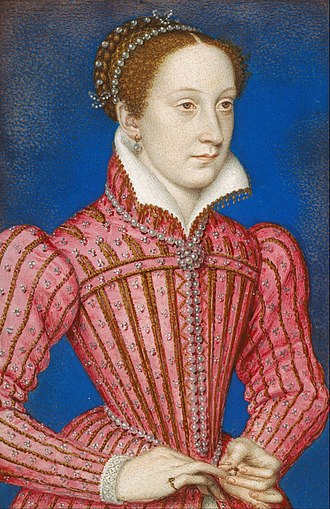
Childhood
Mary was born on 8 December 1542 at Linlithgow Palace, Scotland, to King James V and his French second wife, Mary of Guise. She was said to have been born prematurely and was the only legitimate child of James’ to survive him. She was the great-niece of King Henry VIII of England (her paternal grandmother, Margaret Tudor, was Henry VIII’s sister). On December 14, just six days after her birth, she became Queen of Scotland when her father died.
A popular tale, first recorded by John Knox, states that James, upon hearing on his deathbed that his wife had given birth to a daughter, ruefully exclaimed, “It cam wi’ a lass and it will gang wi’ a lass!” His House of Stuart had gained the throne of Scotland via the marriage of Marjorie Bruce (daughter of Robert the Bruce) to Walter Stewart, 6th High Steward of Scotland. The crown had come to his family through a woman, and would be lost from his family through a woman. This legendary statement came true much later (not through Mary, but through her descendant Anne, Queen of Great Britain).
Mary was baptised at the nearby Church of St Michael shortly after her birth. Rumours spread that she was weak and frail, but English diplomat Ralph Sadler saw the infant at Linlithgow Palace in March 1543 and wrote: “It is as goodly a child as I have seen of her age, and as like to live.”
As Mary was an infant when she inherited the throne, Scotland was ruled by regents until she became an adult. From the outset there were two claims to the regency: one from the Catholic Cardinal Beaton, and the other from the Protestant Earl of Arran, who was next in line to the throne. Beaton’s claim was based on a version of the king’s will that his opponents dismissed as a forgery. Arran, with the support of his friends and relations, became the regent until 1554 when Mary’s mother managed to remove and succeed him.
Treaty of Greenwich
King Henry VIII of England took the opportunity of the regency to propose marriage between Mary and his own son and heir, Edward, hoping for a union of Scotland and England. On 1 July 1543, when Mary was six months old, the Treaty of Greenwich was signed, which promised that, at the age of ten Mary would marry Edward and move to England where Henry could oversee her upbringing. The treaty provided that the two countries would remain legally separate and, shouldthe couple fail to have children, the temporary union would dissolve. Cardinal Beaton rose to power again and began to push a pro-Catholic pro-French agenda, angering Henry, who wanted to break the Scottish alliance with France.
Beaton wanted to move Mary away from the coast to the safety of Stirling Castle. Regent Arran resisted the move, but backed down when Beaton’s armed supporters gathered at Linlithgow. Mary and her mother were escorted to Stirling on 27 July 1543 with the Earl of Lennox and 3,500 armed men. Mary was crowned in the castle chapel on 9 September 1543, with “such solemnity as they do use in this country, which is not very costly”, according to the reports of Ralph Sadler and Henry Ray.
Shortly before Mary’s coronation, Henry arrested Scottish merchants headed for France and impounded their goods. The arrests caused anger in Scotland with Arran joining Beaton and becoming a Catholic. The Treaty of Greenwich was rejected by the Parliament of Scotland in December. The rejection of the marriage treaty and the renewal of the alliance between France and Scotland prompted Henry’s “Rough Wooing“, a military campaign designed to impose the marriage of Mary to his son. English forces mounted a series of raids on Scottish and French territory. In May 1544, the English Earl of Hertford raided Edinburgh, and the Scots took Mary to Dunkeld for safety.
In May 1546, Beaton was murdered by Protestant lairds and on 10 September 1547 (nine months after the death of Henry VII) the Scots suffered a heavy defeat at the Battle of Pinkie Cleugh. Mary’s guardians, fearful for her safety, sent her to Inchmahome Priory for no more than three weeks and turned to the French for help.
King Henry II of France proposed to unite France and Scotland by marrying the young queen to his three-year-old son, the Dauphin Francis. On the promise of French military help and a French dukedom for himself, Arran agreed to the marriage. In February 1548 Mary was moved again for her safety to Dumbarton Castle. The English left a trail of devastation behind them once more and seized the strategic town of Haddington. In June, the much awaited French help arrived at Leith to besiege and ultimately take Haddington. On 7 July 1548, a Scottish Parliament held at a nunnery near the town agreed to the French marriage treaty.
Life in France
With her marriage agreement in place, five-year-old Mary was sent in France to spend the next thirteen years at the French court. The French fleet sent by Henry II was commanded by Nicolas de Villegagnon, sailed with Mary from Dumbarton on 7 August 1548 and arrived within a week or more at Roscoff or Saint-Pol-de-Léon in Brittany.
Mary was accompanied by her own court including two illegitimate half-brothers and the “four Marys” (four girls her own age, all named Mary), who were the daughters of some of the noblest families in Scotland: Beaton, Seton, Fleming, and Livingston. Janet, Lady Fleming (Mary Fleming’s mother and James V’s half-sister) was appointed governess. When Lady Fleming left France in 1551 she was succeeded by French governess Françoise de Paroy.
Vivacious, beautiful and clever (according to contemporary accounts), Mary had a promising childhood. At the French court she was a favourite with everyone, except Henry II’s wife Catherine de’ Medici. Mary learned to play lute and virginals and was competent in prose, poetry, horsemanship, falconry as well as needlework. She was also taught French, Italian, Latin, Spanish and Greek, in addition to speaking her native Scots. Her future sister-in-law, Elisabeth of Valois, became a close friend of whom Mary “retained nostalgic memories in later life“. Mary’s maternal grandmother, Antoinette de Bourbon, was another strong influence on her childhood and acted as one of her principal advisors.
Portraits of Mary show that she had a small, oval-shaped head, a long, graceful neck, bright auburn hair, hazel-brown eyes, under heavy lowered eyelids with finely arched brows, smooth pale skin, a high forehead and regular, firm features. She was considered a pretty child and strikingly attractive as a woman.
Mary was eloquent and especially tall, even by modern standards (she attained an adult height of 5 ft 11 in (1.80 m),) while Henry II’s son and heir, Francis, stuttered and was unusually short. Henry commented: “from the very first day they met, my son and she got on as well together as if they had known each other for a long time“. On 4 April 1558, Mary signed a secret agreement bequeathing Scotland and her claim to England to the French crown if she died without issue. Twenty days later, she married the Dauphin at Notre Dame de Paris.
Claim to the English Throne
In November 1558, Henry VIII’s elder daughter, Mary I of England, was succeeded by her only surviving sibling, Elizabeth I. Under the Third Succession Act passed in 1543 by the Parliament of England, Elizabeth was recognised as her sister’s heir as Henry VIII’s last will and testament had excluded the Stuarts from succeeding to the English throne. Yet in the eyes of many Catholics Elizabeth was illegitimate, thereby rendering Mary Stuart the rightful queen of England as the senior surviving legitimate descendant of Henry VII through her grandmother, Margaret Tudor. Henry II of France proclaimed his eldest son and daughter-in-law king and queen of England and in France the royal arms of England were quartered with those of Francis and Mary. Mary’s claim to the English throne was a perennial sticking point between herself and Elizabeth.
When Henry II died on 10 July 1559 from injuries sustained in a joust, fifteen-year-old Francis and sixteen-year-old Mary became king and queen of France. The Duke of Guise and the Cardinal of Lorraine (two of Mary’s uncles) became dominant in French politics.
In Scotland, the power of the Protestant Lords of the Congregation was rising at the expense of Mary’s mother, who maintained effective control only through the use of French troops. The Protestant Lords invited English troops into Scotland in an attempt to secure Protestantism and the Tumult of Amboise (a Huguenot uprising in France) in March 1560 made it impossible for the French to send further support. On 11 June 1560, Mary’s mother died and pressure was put on the future Franco-Scots relations.
Under the terms of the Treaty of Edinburgh (signed by Mary’s representatives on 6 July 1560) France and England were obliged to withdraw troops from Scotland while France was also made to recognise Elizabeth’s right in ruling England. But the seventeen-year-old Mary, still in France and grieving for her mother, refused to ratify the treaty.
Return to Scotland
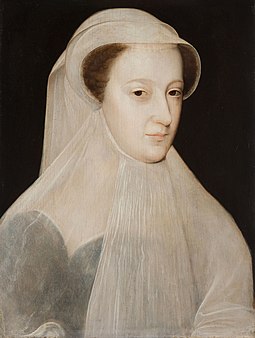
King Francis II died on 5 December 1560 from a middle ear infection that led to an abscess in his brain. Mary was grief-stricken. Catherine de’ Medici became regent for the late king’s ten-year-old brother Charles IX, who inherited the French throne. Mary returned to Scotland nine months later, arriving in Leith on 19 August 1561.
Having lived in France since the age of five, Mary had little direct experience of the dangerous and complex political situation in Scotland. Scotland was torn between Catholic and Protestant factions and Mary’s illegitimate half-brother, the Earl of Moray, was a leader of the Protestants. Protestant reformer John Knox preached against Mary, condemning her for hearing Mass, dancing and dressing too elaborately. Mary summoned him to her presence to remonstrate with him unsuccessfully and later charged him with treason, but he was acquitted and released.
To the disappointment of the Catholic party, and against their expectations, Mary tolerated the newly established Protestant ascendancy and kept her half-brother Lord Moray as her chief advisor. Her privy council of 16 men, appointed on 6 September 1561 retained those who already held the offices of state and was dominated by the Protestant leaders from the reformation crisis of 1559–1560.
Mary sent William Maitland of Lethington as an ambassador to the English court to put the case for Mary as the heir presumptive to the English throne. Elizabeth refused to name a potential heir, fearing that it would invite conspiracy to displace her with the nominated successor, but she assured Maitland that she knew no one with a better claim than Mary. In late 1561 and early 1562, arrangements were made for the two queens to meet in England at York or Nottingham in August or September 1562, but Elizabeth sent Sir Henry Sidney to cancel in July because of the civil war in France.
Mary turned her attention to finding a new husband from the royalty of Europe. Her attempt to negotiate a marriage to Don Carlos, the mentally unstable heir apparent of King Philip II of Spain, was rebuffed by Philip himself. Elizabeth attempted to neutralise Mary by suggesting that she marry English Protestant Robert Dudley, 1st Earl of Leicester, whom Elizabeth trusted and thought she could control. She sent ambassador Thomas Randolph to tell Mary that if she married an English nobleman, Elizabeth would “proceed to the inquisition of her right and title to be our next cousin and heir“. The proposal came to nothing, not least because the intended bridegroom was unwilling.
In contrast, a French poet at Mary’s court, Pierre de Boscosel de Chastelard, was apparently besotted with Mary. In early 1563 he was discovered during a security search hidden underneath her bed, apparently planning to surprise her when she was alone and declare his love for her. Mary was horrified and banished him from Scotland. He ignored the edict and two days later he forced his way into her chamber as she was about to disrobe. She reacted with fury and fear. When Moray rushed into the room, in reaction to her cries for help, she shouted, “Thrust your dagger into the villain!“, which Moray refused to do, as Chastelard was already under restraint. Chastelard was trialed for treason and beheaded.
Marriage to Lord Danley
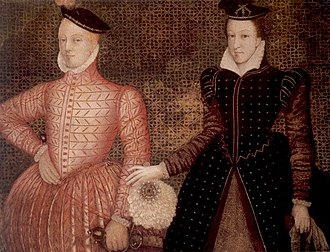
Mary had briefly met her English-born half-cousin Henry Stuart, Lord Darnley in February 1561 when she was in mourning for Francis. Darnley’s parents, the Earl and Countess of Lennox, who were Scottish aristocrats as well as English landowners, had sent him to France ostensibly to extend their condolences while hoping for a potential match between their son and Mary. They next met on Saturday 17 February 1565 at Wemyss Castle in Scotland, after which Mary fell in love with the “long lad” (as Queen Elizabeth called him). They married at Holyrood Palace on 29 July 1565, even though both were Catholic and hadn’t obtained a papal dispensation for the marriage of first cousins.
English statesmen William Cecil and the Earl of Leicester had worked to obtain Darnley’s licence to travel to Scotland from his home in England. Although her advisors had thus brought the couple together, Elizabeth felt threatened by the marriage, because both Mary and Darnley were claimants to the English throne (as descendants of her aunt) and their children, if any, would inherit an even stronger, combined claim. Mary’s insistence on the marriage seems to have stemmed from passion rather than calculation.
Mary’s marriage to a leading Catholic precipitated Mary’s half-brother, the Earl of Moray, to join with other Protestant lords in open rebellion. Mary set out from Edinburgh on 26 August 1565 to confront them, and on the 30th Moray entered Edinburgh. However, he left soon afterward having failed to take the castle. Mary returned to Edinburgh the following month to raise more troops. In what became known as the Chaseabout Raid, Mary and her forces and Moray with the rebellious lords roamed around Scotland without ever engaging in direct combat. Mary’s numbers were boosted by the release and restoration to favour of Lord Huntly’s son and the return of James Hepburn, 4th Earl of Bothwell from exile in France.
Unable to muster sufficient support, Moray left Scotland in October for asylum in England. Mary broadened her privy council, bringing in both Catholics (Bishop of Ross John Lesley and provost of Edinburgh Simon Preston of Craigmillar) and Protestants (the new Lord Huntly, Bishop of Galloway Alexander Gordon, John Maxwell of Terregles and Sir James Balfour).
Before long, Darnley grew arrogant. Not content with his position as king consort he demanded the Crown Matrimonial, which would have made him a co-sovereign of Scotland with the right to keep the Scottish throne for himself if he outlived his wife. Mary refused his request and their marriage grew strained even though they conceived by October 1565. He was jealous of her friendship with her Catholic private secretary, David Rizzio, who was rumoured to be the father of her child. By March 1566, Darnley had entered into a secret conspiracy with Protestant lords, including the nobles who had rebelled against Mary in the Chaseabout Raid. On 9 March a group of the conspirators accompanied by Darnley, murdered Rizzio in front of the pregnant Mary at a dinner party in Holyrood Palace. Over the next two days, a disillusioned Darnley switched sides and Mary received Moray at Holyrood.
On the night of 11–12 March, Darnley and Mary escaped from the palace and took temporary refuge in Dunbar Castle before returning to Edinburgh on 18 March.
Murder of Darnley
Mary’s son by Darnley, James, was born on 19 June 1566 in Edinburgh Castle, but the murder of Rizzio led inevitably to the breakdown of her marriage. In October 1566, while staying at Jedburgh in the Scottish Borders, Mary made a journey on horseback of at least four hours each way to visit the Earl of Bothwell at Hermitage Castle, where he lay ill from wounds sustained in a skirmish with border reivers. The ride was later used as evidence by Mary’s enemies that the two were lovers, though no suspicions were voiced at the time and Mary had been accompanied by her councillors and guards.
Immediately after her return to Jedburgh she suffered a serious illness that included frequent vomiting, loss of sight, loss of speech, convulsions and periods of unconsciousness. She was thought to be near death or dying. Her recovery from 25 October onwards was credited to the skill of her French physicians. The cause of her illness is unknown; diagnoses include physical exhaustion and mental stress, haemorrhage of a gastric ulcer, and porphyria.
At Craigmillar Castle at the end of November 1566, Mary and leading nobles held a meeting to discuss the “problem of Darnley“. Divorce was discussed, but a bond was probably sworn between the lords present to remove Darnley by other means: “It was thought expedient and most profitable for the common wealth … that such a young fool and proud tyrant should not reign or bear rule over them; … that he should be put off by one way or another; and whosoever should take the deed in hand or do it, they should defend.“
Darnley feared for his safety and after the baptism of his son at Stirling shortly before Christmas he went to Glasgow to stay on his father’s estates. At the start of the journey he was afflicted by a fever (possibly smallpox, syphilis, or the result of poison) and he remained ill for some weeks.
In late January 1567, Mary prompted her husband to return to Edinburgh. He recuperated from his illness in a house belonging to the brother of Sir James Balfour at the former abbey of Kirk o’ Field, just within the city wall. Mary visited him daily, so that it appeared a reconciliation was in progress. On the night of 9–10 February 1567, Mary visited her husband in the early evening and then attended the wedding celebrations of a member of her household, Bastian Pagez. In the early hours of the morning, an explosion devastated Kirk o’ Field and Darnley was found dead in the garden. There were no visible marks of strangulation or violence on the body. Bothwell, Moray, Secretary Maitland, the Earl of Morton and Mary herself were among those who came under suspicion.
Elizabeth wrote to Mary of the rumours, “I should ill fulfil the office of a faithful cousin or an affectionate friend if I did not … tell you what all the world is thinking. Men say that, instead of seizing the murderers, you are looking through your fingers while they escape; that you will not seek revenge on those who have done you so much pleasure, as though the deed would never have taken place had not the doers of it been assured of impunity. For myself, I beg you to believe that I would not harbour such a thought.”
By the end of February, Bothwell was generally believed to be guilty of Darnley’s assassination. Lennox (Darnley’s father) demanded that Bothwell be tried before the Estates of Parliament to which Mary agreed, but Lennox’s request for a delay to gather evidence was denied. In the absence of Lennox and with no evidence presented, Bothwell was acquitted after a seven-hour trial on 12 April. A week later, Bothwell managed to convince more than two dozen lords and bishops to sign the Ainslie Tavern Bond, in which they agreed to support his aim to marry the queen
Imprisonment in Scotland and abdication
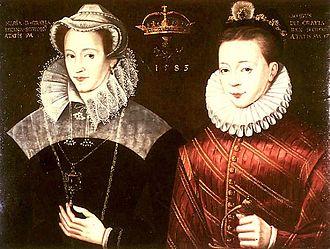
Between 21 and 23 April 1567, Mary visited her son at Stirling for the last time. On her way back to Edinburgh on 24 April, Mary was abducted, willingly or not, by Lord Bothwell and his men and taken to Dunbar Castle. On 6 May, Mary and Bothwell returned to Edinburgh and on 15 May they were married according to Protestant rites. Bothwell and his first wife, Jean Gordon, had divorced twelve days previously.
Originally Mary believed that many nobles supported her marriage, but relations quickly soured between the newly elevated Bothwell (created Duke of Orkney) and his former peers, and the marriage proved to be deeply unpopular. Catholics considered the marriage unlawful, since they did not recognise Bothwell’s divorce or the validity of the Protestant service. Both Protestants and Catholics were shocked that Mary would marry the man accused of murdering her husband. The marriage was tempestuous and Mary became despondent.
Twenty-six Scottish peers, known as the confederate lords, turned against Mary and Bothwell, raising an army against them. Mary and Bothwell confronted them at Carberry Hill on 15 June, but there was no battle as Mary’s forces dwindled away through desertion during negotiations. Bothwell was given safe passage from the field and the lords took Mary to Edinburgh, where crowds of spectators denounced her as an adulteress and murderer. The following night, she was imprisoned in Loch Leven Castle.
Between 20 and 23 July, Mary miscarried twins. On 24 July, she was forced to abdicate in favour of her one-year-old son James. Moray was made regent, while Bothwell was imprisoned in Denmark, became insane and later died in 1578.
Escape and imprisonment in England
On 2 May 1568, Mary escaped from Loch Leven Castle with the aid of George Douglas, brother of Sir William Douglas, the castle’s owner.Managing to raise an army of 6,000 men, she met Moray’s smaller forces at the Battle of Langside on 13 May. Defeated, she fled south. After spending the night at Dundrennan Abbey, she crossed the Solway Firth into England by fishing boat on 16 May. She landed at Workington in Cumberland in the north of England and stayed overnight at Workington Hall. On 18 May, local officials took her into protective custody at Carlisle Castle.
Mary apparently expected Elizabeth to help her regain her throne. Elizabeth was cautious, ordering an inquiry into the conduct of the confederate lords and the question of whether Mary was guilty of Darnley’s murder. In mid-July 1568, English authorities moved Mary to Bolton Castle, further from the Scottish border but not too close to London. A commission of inquiry was held in York and later Westminster between October 1568 and January 1569. In Scotland, her supporters fought a civil war against Regent Moray and his successors.
Casket Letters
As an anointed queen, Mary refused to acknowledge the power of any court to try her and refused to attend the inquiry at York personally, but Elizabeth forbade her attendance anyway. As evidence against Mary, Moray presented the so-called casket letters (eight unsigned letters purportedly from Mary to Bothwell, two marriage contracts and a love sonnet or sonnets said to have been found in a silver-gilt casket just less than 30 cm long, decorated with the monogram of King Francis II).
Mary denied writing them, arguing that her handwriting was not difficult to imitate and insisted they were forgeries. The letters are widely believed to be crucial as to whether Mary shares the guilt for Darnley’s murder.
The authenticity of the casket letters has been the source of much controversy among historians. It is impossible now to prove either way. The originals, written in French, were probably destroyed in 1584 by Mary’s son. The surviving copies, in French or translated into English, do not form a complete set. There are incomplete printed transcriptions in English, Scots, French, and Latin from the 1570s. Other documents scrutinised included Bothwell’s divorce from Jean Gordon. Moray had sent a messenger in September to Dunbar to get a copy of the proceedings from the town’s registers.
The casket letters did not appear publicly until the Conference of 1568, although the Scottish privy council had seen them by December 1567. Mary had been forced to abdicate and held captive for the best part of a year in Scotland. The letters were never made public to support her imprisonment and forced abdication. Historian Jenny Wormald believes this reluctance on the part of the Scots to produce the letters and their destruction in 1584, whatever their content, constitute proof that they contained real evidence against Mary, whereas Weir thinks it demonstrates the lords required time to fabricate them. At least some of Mary’s contemporaries who saw the letters had no doubt that they were genuine.
The majority of the commissioners accepted the casket letters as genuine after a study of their contents and comparison of the penmanship with examples of Mary’s handwriting. Elizabeth, as she had wished, concluded the inquiry with a verdict that nothing was proven, either against the confederate lords or Mary. In the end, Moray returned to Scotland as its regent, and Mary remained in custody in England. Elizabeth had succeeded in maintaining a Protestant government in Scotland, without either condemning or releasing her fellow sovereign.
Plots
On 26 January 1569, Mary was moved to Tutbury Castle and placed in the custody of the Earl of Shrewsbury and his formidable wife Bess of Hardwick. Elizabeth considered Mary’s designs on the English throne to be a serious threat and so confined her to Shrewsbury’s properties, including Tutbury, Sheffield Castle, Sheffield Manor Lodge, Wingfield Manor and Chatsworth House.
Mary was permitted her own domestic staff, which never numbered fewer than sixteen and needed 30 carts to transport her belongings from house to house. Her chambers were decorated with fine tapestries and carpets, as well as her cloth of state on which she had the French phrase, En ma fin est mon commencement (“In my end lies my beginning“), embroidered. Her bedlinen was changed daily and her own chefs prepared meals with a choice of 32 dishes served on silver plates.
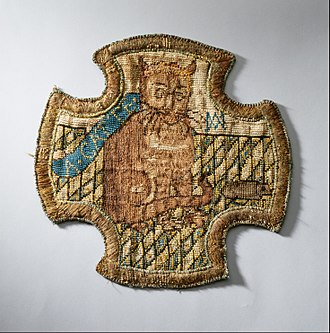
She was occasionally allowed outside under strict supervision, spent seven summers at the spa town of Buxton and spent much of her time doing embroidery. Her health declined, perhaps through porphyria or lack of exercise and by the 1580s she had severe rheumatism in her limbs, rendering her lame.
In May 1569, Elizabeth attempted to mediate the restoration of Mary in return for guarantees of the Protestant religion, but a convention held at Perth rejected the deal overwhelmingly. Early in 1571, Moray was assassinated. His death coincided with a rebellion in the North of England, led by Catholic earls, which persuaded Elizabeth that Mary was a threat. Elizabeth’s principal secretaries, Sir Francis Walsingham and William Cecil, Lord Burghley, watched Mary carefully with the aid of spies placed in her household.
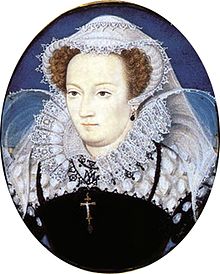
In 1571, Cecil and Walsingham uncovered the Ridolfi Plot, a plan to replace Elizabeth with Mary with the help of Spanish troops and the Duke of Norfolk. Norfolk was executed and the English Parliament introduced a bill barring Mary from the throne, to which Elizabeth refused to give royal assent.
Plots centred on Mary continued. Pope Gregory XIII endorsed one plan in the latter half of the 1570s to marry her to the governor of the Low Countries and illegitimate half-brother of Philip II of Spain, John of Austria, who was supposed to organise the invasion of England from the Spanish Netherlands.
After the Throckmorton Plot of 1583, Walsingham introduced the Bond of Association and the Act for the Queen’s Safety, which sanctioned the killing of anyone who plotted against Elizabeth and aimed to prevent a putative successor from profiting from her murder.
In 1584, Mary proposed an “association” with her son, James. She announced that she was ready to stay in England, to renounce the Pope’s bull of excommunication and to retire, abandoning her pretensions to the English Crown. She also offered to join an offensive league against France. For Scotland, she proposed a general amnesty, agreed that James should marry with Elizabeth’s knowledge and that there should be no change in religion.
Her only condition was the immediate alleviation of the conditions of her captivity. James went along with the idea for a while but then rejected it and signed an alliance treaty with Elizabeth, abandoning his mother. Elizabeth also rejected the association, because she did not trust Mary to cease plotting against her during the negotiations.
In February 1585, William Parry was convicted of plotting to assassinate Elizabeth, without Mary’s knowledge, although her agent Thomas Morgan was implicated. In April, Mary was placed in the stricter custody of Sir Amias Paulet and at Christmas she was moved to a moated manor house at Chartley.
Trial
On 11 August 1586, after being implicated in the Babington Plot, Mary was arrested while out riding and taken to Tixall. In a successful attempt to entrap her, Walsingham had deliberately arranged for Mary’s letters to be smuggled out of Chartley. Mary was misled into thinking her letters were secure, while in reality they were deciphered and read by Walsingham. From these letters it was clear that Mary had sanctioned the attempted assassination of Elizabeth.
She was moved to Fotheringhay Castle in a four-day journey ending on 25 September and in October was put on trial for treason under the Act for the Queen’s Safety before a court of 36 noblemen. Spirited in her defence, Mary denied the charges. She told her triers, “Look to your consciences and remember that the theatre of the whole world is wider than the kingdom of England“.
She protested that she had been denied the opportunity to review the evidence, that her papers had been removed from her, that she was denied access to legal counsel and that as a foreign anointed queen she had never been an English subject and thus could not be convicted of treason.
Mary was convicted on 25 October and sentenced to death with only one commissioner, Lord Zouche, expressing any form of dissent. Nevertheless, Elizabeth hesitated to order her execution, even in the face of pressure from the English Parliament to carry out the sentence. She was concerned that the killing of a queen set a discreditable precedent and was fearful of the consequences especially if, in retaliation, Mary’s son, James, formed an alliance with the Catholic powers and invaded England.
On 1 February 1587, Elizabeth signed the death warrant and entrusted it to William Davison, a privy councillor. On 3 February, ten members of the Privy Council of England, having been summoned by Cecil without Elizabeth’s knowledge, decided to carry out the sentence at once.
Execution
At Fotheringhay, on the evening of 7 February 1587, Mary was told she was to be executed the next morning. She spent the last hours of her life in prayer, distributing her belongings to her household and writing her will as well as a letter to the King of France. The scaffold that was erected in the Great Hall was draped in black cloth. It was reached by two or three steps, and furnished with the block, a cushion for her to kneel on and three stools, for her and the earls of Shrewsbury and Kent, who were there to witness the execution.
The executioners knelt before her and asked forgiveness, as it was typical for the executioner to request the pardon of the one being put to death. Mary replied, “I forgive you with all my heart, for now, I hope, you shall make an end of all my troubles.” Her servants, Jane Kennedy and Elizabeth Curle and the executioners helped Mary remove her outer garments, revealing a velvet petticoat and a pair of sleeves in crimson brown, the liturgical colour of martyrdom in the Catholic Church, with a black satin bodice and black trimmings.She was blindfolded by Kennedy with a white veil embroidered in gold, knelt down on the cushion in front of the block, on which she positioned her head and stretched out her arms. Her last words were, In manus tuas, Domine, commendo spiritum meum (“Into thy hands, O Lord, I commend my spirit“).
Mary was not beheaded with a single strike. The first blow missed her neck and struck the back of her head. The second blow severed the neck, except for a small bit of sinew, which the executioner cut through using the axe. Afterwards, he held her head aloft and declared, “God save the Queen.”

Mary’s request to be buried in France was refused by Elizabeth. Her body was embalmed and left in a secure lead coffin until her burial in a Protestant service, at Peterborough Cathedral in late July 1587. Her entrails, removed as part of the embalming process, were buried secretly within Fotheringhay Castle.
Her body was exhumed in 1612, when her son, King James VI and I, ordered that she be reinterred in Westminster Abbey in a chapel opposite the tomb of Elizabeth. In 1867, her tomb was opened in an attempt to ascertain the resting place of James I. He was ultimately found with Henry VII, but many of her other descendants, including Elizabeth of Bohemia, Prince Rupert of the Rhine and the children of Anne, Queen of Great Britain, were interred in her vault.
